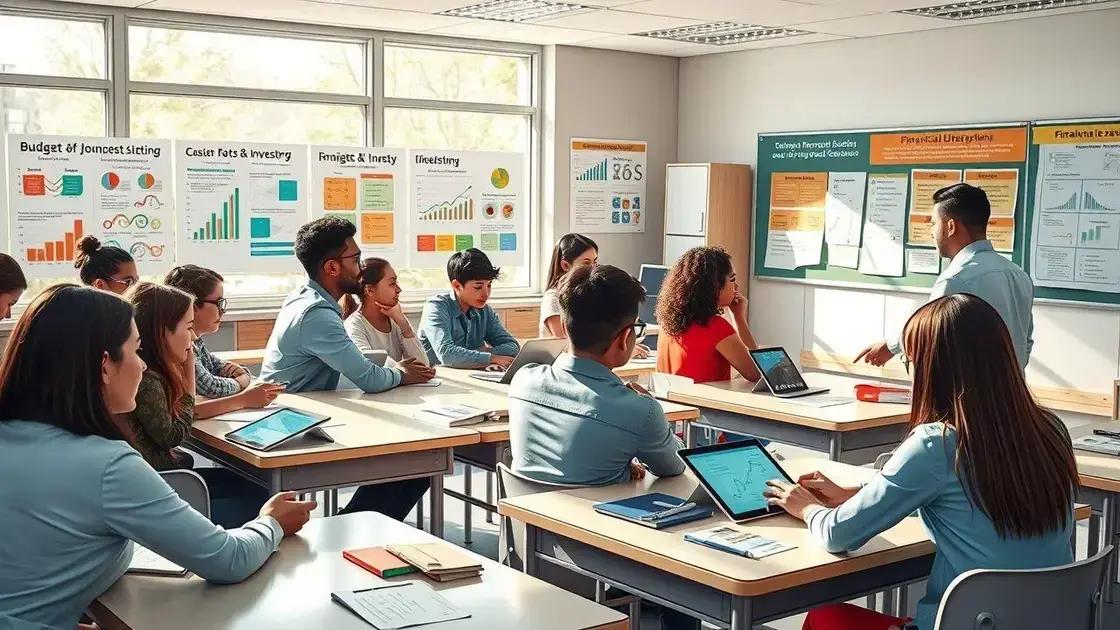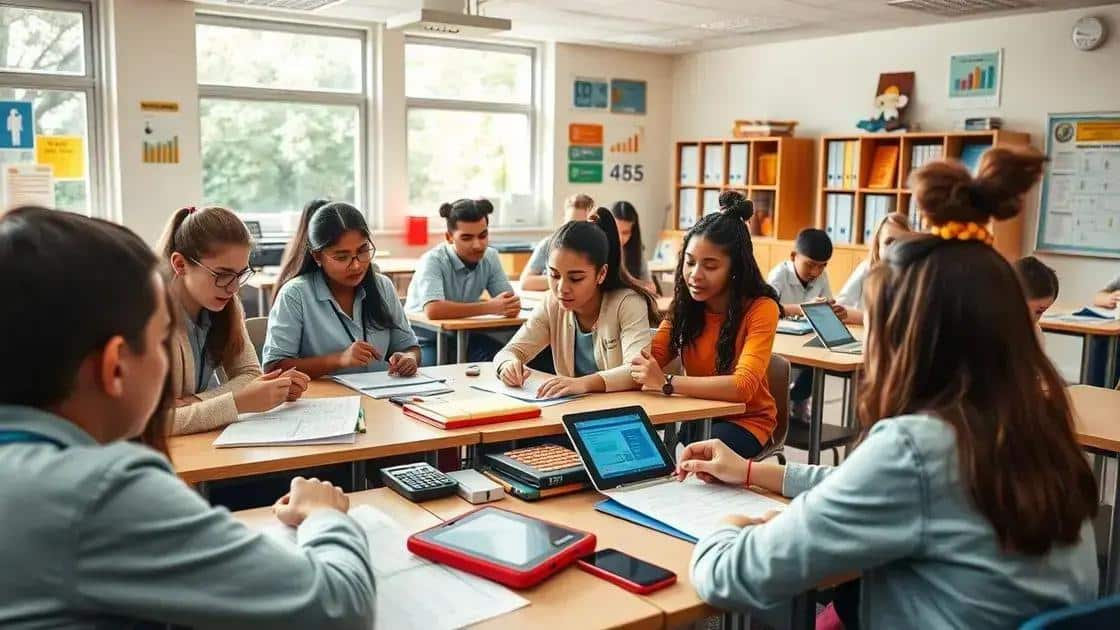Rich financial literacy in schools: unlock student potential

Rich financial literacy in schools is crucial for empowering students with essential money management skills, enabling them to make informed financial decisions throughout their lives.
Rich financial literacy in schools offers students essential tools for navigating their futures. Have you ever considered how financial knowledge could transform their lives? Let’s dive into its significance and effective teaching approaches.
The importance of financial literacy education
Understanding financial literacy is vital for young minds in today’s world. With the complexities of money management and financial systems, schools play a key role in teaching students essential skills. Not only does this knowledge help them make informed decisions, but it also prepares them for future financial challenges.
The Role of Schools in Financial Education
Schools are the primary supporters of financial awareness. By integrating financial literacy into the curriculum, educators can equip students with the necessary tools for economic success. This creates a foundation for responsible adulthood.
Key Benefits
- Encourages smart spending and saving habits.
- Prepares students for real-world financial responsibilities.
- Boosts confidence in managing personal finances.
- Promotes informed decision-making regarding investments and loans.
Additionally, engaging students through real-life applications can solidify their understanding. For example, discussing budgeting for a school event can illustrate practical financial concepts. It’s essential to connect classroom learning with real-world scenarios, making financial literacy relatable and impactful.
Community Involvement
Financial literacy education can be strengthened by involving the community. Partnerships with local businesses can enrich learning experiences. Guest speakers or workshops can invite professionals to share valuable insights.
Encouraging students to participate in community service related to finance can also enhance their skills. Whether it’s helping families with budgeting or volunteering with local charities, these experiences cement financial concepts.
In conclusion, embracing financial literacy in schools is crucial. It lays a strong foundation for students, empowering them to tackle future financial challenges with confidence and knowledge.
Effective strategies for teaching financial skills
Teaching financial skills is essential in today’s world. It’s vital for students to learn about budgeting, saving, and investing. However, effective strategies can make this process engaging and productive. By using interactive methods, schools can spark students’ interest in managing their finances.
Incorporating Real-Life Scenarios
One of the best ways to teach financial skills is by integrating real-life scenarios into lessons. By presenting students with practical situations, they can apply their knowledge practically. For example, role-playing activities can simulate budgeting for an event or managing a small business.
Using Games and Technology
Games make learning about finance fun and interactive. There are numerous educational games that relate to financial literacy. These can help students grasp complex concepts easily. Many educational apps allow students to manage virtual money, helping them learn about saving and spending wisely.
- Financial simulations that mimic global markets.
- Board games that teach budgeting and investment.
- Apps for tracking personal savings.
Additionally, incorporating technology into lessons can enhance engagement. Online resources and interactive videos provide diverse perspectives on managing money. Students can explore topics at their own pace, promoting independence in learning.
Collaboration with Community Experts
Inviting community members who are financial experts to present in classrooms can enrich the learning experience. This exposure allows students to ask questions and gain insights from real-world professionals. Students can understand the relevance of financial skills in their future careers.
Project-based learning also allows students to dive deeper into financial topics. Group projects can focus on creating budgets or developing investment plans. By collaborating, students enhance their teamwork skills while gaining hands-on experience in finance.
To summarize, effective strategies for teaching financial skills include real-life scenarios, educational games, and collaboration with experts. These methods create an engaging atmosphere where students can thrive and develop essential financial knowledge.
Creating engaging financial literacy curricula

Creating engaging financial literacy curricula is crucial for capturing students’ attention and fostering a genuine interest in managing their finances. Students need lessons that relate to their lives, making it easier for them to understand the importance of financial skills.
Incorporating Relevant Topics
To develop an engaging curriculum, educators should focus on topics that resonate with young people. This can include budgeting for college, understanding student loans, and the basics of credit scores. By covering practical subjects, students will see the value in learning these essential skills.
Utilizing Interactive Learning
Interactive learning techniques can significantly enhance student engagement. Teachers can implement hands-on activities such as group projects or simulations that require students to manage budgets or invest in a mock stock market. Such activities make financial literacy tangible and relatable.
- Developing a classroom store where students can manage finances.
- Using real-world case studies to discuss financial decisions.
- Incorporating technology through apps and online platforms.
Moreover, encouraging students to participate in community service related to finance can create real-world applications of what they learn. For example, they might help local non-profits with budgeting or financial planning, enhancing their understanding while benefiting the community.
Involving Stakeholders
Involving parents and local businesses in the curriculum development process can also enrich the educational experience. Guest speakers from various financial sectors can provide insights that inspire students. Students can gain firsthand knowledge about different career paths in finance, making their education more relevant and exciting.
By blending various teaching methods and topics, educators can create a dynamic financial literacy curriculum that not only informs but also inspires. Engaging students through practical examples, interactive activities, and community involvement can lead to more effective learning outcomes.
Assessing financial literacy in students
Assessing financial literacy in students is crucial for understanding their comprehension of key concepts. This process helps educators identify areas where students excel and where they may need additional support. Effective assessment methods can provide valuable insights into students’ financial knowledge and skills.
Creating Assessment Tools
To assess financial literacy, teachers can develop a variety of assessment tools. These can include quizzes, projects, and portfolios that showcase students’ understanding of financial concepts. A well-rounded assessment will include both theoretical knowledge and practical application.
Using Practical Assessments
Practical assessments can be particularly effective in measuring students’ understanding. For instance, having students create a personal budget or a savings plan allows them to apply what they have learned in real-life situations. Such activities promote active participation and make the learning process more engaging.
- Designing role-play scenarios for budget management.
- Conducting group discussions on financial decision-making.
- Implementing case studies to analyze real-world financial issues.
Additionally, providing students with scenarios to analyze can encourage critical thinking. Assessing their responses in these scenarios can reveal their ability to make sound financial decisions. Incorporating self-assessments also encourages reflection, allowing students to identify their strengths and weaknesses in financial literacy.
Feedback and Improvement
After assessments, providing constructive feedback is vital. This helps students understand what they did well and where they can improve. Creating an environment where students feel comfortable discussing their challenges encourages growth in financial literacy.
By regularly evaluating students’ financial literacy, educators can tailor their teaching strategies to better meet student needs. It becomes easier to develop engaging lesson plans and activities that address knowledge gaps, thus improving overall financial literacy in the classroom.
Collaborating with parents and the community
Collaborating with parents and the community is essential for enhancing financial literacy education in schools. When families understand financial concepts, they can reinforce what students learn in the classroom, creating a more cohesive learning experience. Engaging the community can also provide valuable resources and real-world insights.
Creating Partnerships
Schools can initiate partnerships with local businesses and financial institutions. These partnerships can lead to workshops, guest speakers, and resources for students and parents. For example, local banks can offer sessions on savings accounts, credit scores, and budgeting.
Involving Parents in Curriculum
Involving parents in the development of the financial literacy curriculum can provide diverse perspectives. Schools can hold meetings to gather input and share ideas. This not only empowers parents but also helps educators understand the financial challenges families face.
- Organizing family financial literacy nights at school.
- Providing resources and guides for parents to use at home.
- Encouraging participation in school-sponsored financial events.
Furthermore, creating a welcoming environment for parents to ask questions can foster open communication about financial matters. Schools can send newsletters that highlight financial literacy topics, offering tips and resources for families to strengthen their financial knowledge.
Community Engagement Activities
Community engagement activities can significantly enhance financial literacy efforts. Organizing events like budgeting workshops or financial planning seminars can provide practical knowledge to both students and parents. These events can also create a platform for discussing local financial resources, such as credit counseling services or budgeting apps.
Having community leaders involved can elevate the importance of financial literacy. Their participation can attract attention and encourage wider community involvement, increasing the overall effectiveness of financial education initiatives.
FAQ – Frequently Asked Questions about Financial Literacy in Schools
What is financial literacy?
Financial literacy is the understanding of important financial concepts such as budgeting, saving, investing, and understanding credit.
Why is financial literacy important for students?
Financial literacy equips students with essential skills for managing money, making informed decisions, and preparing for future financial challenges.
How can parents contribute to their child’s financial literacy education?
Parents can reinforce what students learn by discussing financial topics at home, attending school events, and providing practical experiences like budgeting.
What role does the community play in enhancing financial literacy?
The community can offer resources, workshops, and expert insights that enrich financial literacy programs, making learning more relevant and engaging for students.






